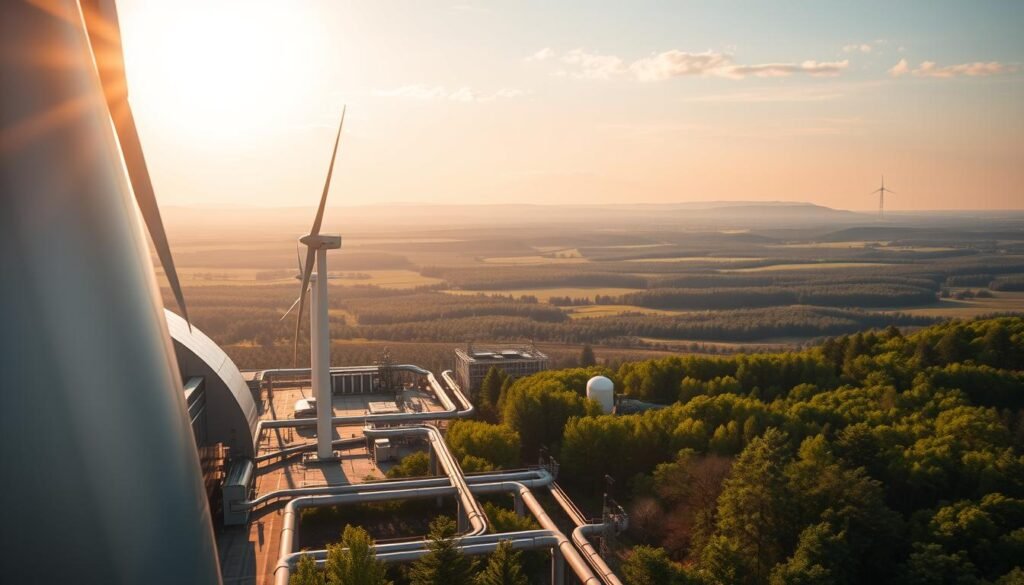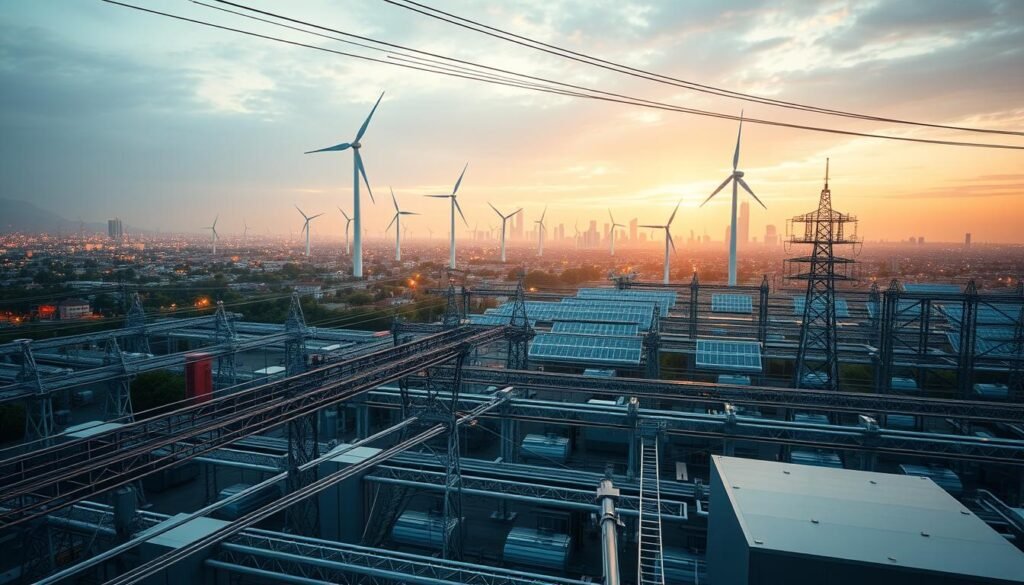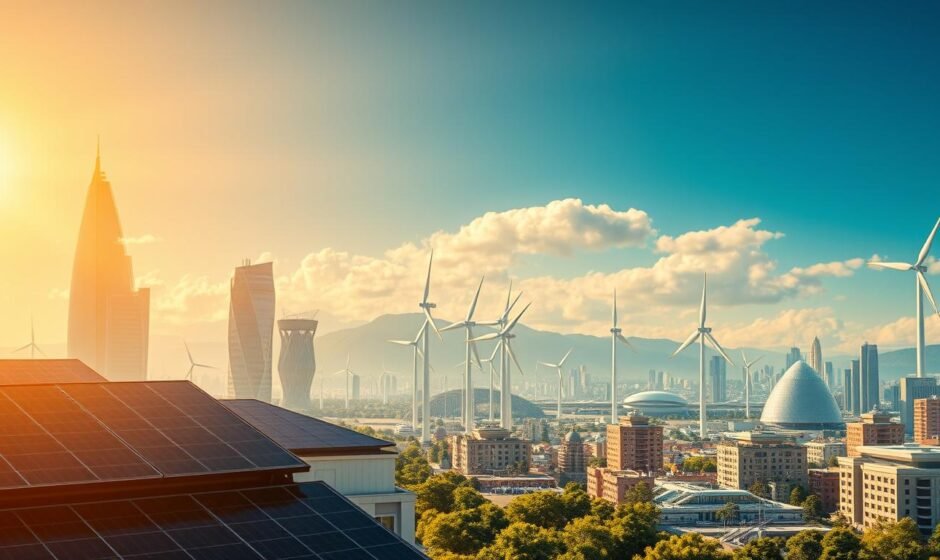In 2023, solar photovoltaic (PV) technology led the way in adding new renewable energy capacity worldwide. This shows how fast sustainable energy is evolving. It’s key to tackling climate change and the shortage of fossil fuels. These new technologies promise a cleaner future and better energy use in many areas.
Advances in solar and wind energy, along with new ways to store energy, are changing the renewable energy scene. The Dogger Bank Wind Farm in the UK is a big example. It aims to power millions of homes using wind energy. Also, enough sunlight hits the Earth every 90 minutes to power the world’s electricity for a year, showing the huge opportunities we have.
Exploring these innovations is vital. They can change how we use energy and interact with the environment. They also help us use resources more wisely.
Key Takeaways
- In 2023, global solar capacity reached 1,200 GW, marking a 22% increase from the previous year.
- The investment in renewable energy technologies is projected to grow significantly, with the energy storage market expected to reach $546 billion by 2035.
- Wind energy is becoming an even larger player, with projections indicating offshore capacity growth from 60 GW in 2023 to over 240 GW by 2030.
- Green hydrogen is set to play a vital role, with the global market expected to surge from $1.2 billion to $89.2 billion by 2030.
- Innovations such as solid-state batteries promise enhanced energy storage solutions, vital for the future of renewable energy.
- AI and machine learning will be key in energy management, with expected revenues of $12 billion by 2028.
The Rise of Solar Panel Technology
As we become more aware of climate change, solar energy is leading the way in renewable solutions. Solar panel efficiency is improving fast, thanks to new breakthroughs. These advancements are making solar power a key part of our energy future.
Advances in Solar Efficiency
Recent breakthroughs have made solar cells over 30% efficient. This is a big step forward in solar technology. Silicon panels are getting close to 29% efficiency.
Lab tests have shown even better results. For example, perovskite-silicon cells have hit 33.7% efficiency. A German team got 32.5% with silicon-perovskite cells, and a Swiss team achieved 31.25% with tandem cells.
Worldwide, solar power capacity reached 1.2 terawatts in 2022. We need to install more solar panels to fight climate change. The International Energy Agency says we need 75 terawatts by 2050 to stop global warming.
BIPV: Solar Energy Integration
BIPV, or Building-Integrated Photovoltaics, is a big step in clean tech. It turns buildings into solar power sources. This makes cities more energy-efficient and less dependent on old energy sources.
For example, Longi has made solar cells up to 33.5% efficient. This shows how buildings can use solar energy better.
The Role of Solar Thermal Systems
Solar thermal systems are key for using and storing solar energy. They turn sunlight into heat for hot water, heating spaces, or industrial uses. As we look for green solutions, solar thermal tech will keep improving.
Innovation is key to a sustainable future. Keeping up with solar panel tech shows us how energy use is changing. Leaders like Dave Hrivnak and his team are leading the way in clean energy and policy changes.
Wind Energy Breakthroughs
Wind energy is advancing fast with new technologies. These changes are key to making sustainable energy a reality. Offshore wind farms are a big step forward, set to change how we get energy in the future.
Offshore Wind Farms: A Game Changer
Offshore wind farms are a big leap in wind energy. They use strong winds in deep water to make more energy. This could cut down on energy imports and boost local jobs.
The National Renewable Energy Laboratory says new tech could unlock 80% more wind energy. This is true for places like the Southeast and Gulf Coast.
Vertical Axis Wind Turbines
Vertical axis wind turbines (VAWT) are a new take on wind energy. They work well in windy but bumpy conditions. They also need less space, making them good for cities and countryside.
New designs let them capture more energy. This is thanks to bigger rotors and better technology.
Innovations in Wind Turbine Design
Wind turbines are getting better with new materials and ways of making them. Taller towers and longer blades reach stronger winds. New methods like spiral welding and 3D printing are making them cheaper.
Also, new systems help turbines last longer and need less fixing. This makes them a reliable source of energy.
| Year | Tower Height (m) | Rotor Diameter (m) | Power Capacity (MW) |
|---|---|---|---|
| 1990s | 30 | 30 | 0.2 |
| 2020s | 90 | 125 | 3 |
| Future Potential | 169 | 150 | Up to 15 |
As we focus more on being green, wind energy will be key. These new technologies are helping us move towards a zero-carbon future. They meet our energy needs by 2040.
Energy Storage Solutions Transforming Reliability
As we move towards renewable energy, energy storage solutions are key to reliability. In 2023, renewable energy capacity grew by 50% globally. This shows the need for strong energy storage systems.
These systems help keep the power stable, managing the ups and downs of renewable energy. New technologies like next-gen lithium-ion batteries and flow batteries are leading the way. They are big steps forward in clean technology advancements and eco-friendly innovation in energy.
Next-Gen Lithium-Ion Batteries
Next-generation lithium-ion batteries are leading the energy storage market. They have better energy density and safety, making them versatile. They help with tasks like keeping the grid stable and reducing peak demand.
Research is ongoing to make these batteries even better. This shows the bright future of lithium-ion batteries in sustainable energy.
Flow Batteries for Large-Scale Storage
Flow batteries are great for storing large amounts of energy. They help make solar and wind power more viable. By linking flow batteries with renewables, we can send power when it’s needed most.
This ensures we have power even when the grid fails. It’s key for using energy from rooftops and other sources.
The Promise of Solid-State Batteries
Solid-state batteries are the next big thing in energy storage. They pack more energy than traditional lithium-ion batteries and are safer. They could change how we store and use energy.
As research continues, solid-state batteries could be a game-changer. The global Battery Energy Storage Systems market is expected to grow to $120 billion to $150 billion by 2030.
Smart grid technology is driving energy management forward. Understanding the energy landscape is key. New storage solutions help balance power supply and demand.
Investments in Battery Energy Storage Systems exceeded $5 billion in 2022. This is a big step towards clean energy. These advancements are leading us to a sustainable energy future. For more on these innovations, check out green energy innovation initiatives.
Geothermal Energy Innovations
Geothermal energy is a valuable resource that could change how we use energy. It has seen big improvements in enhanced geothermal systems (EGS) and using old mines for energy. The direct use of geothermal energy is also interesting, as it helps local energy grids and makes energy more reliable.
Enhanced Geothermal Systems
Enhanced geothermal systems use the Earth’s heat well, helping with green energy. They can use different types of geothermal resources. The U.S. wants to increase its geothermal power from 4 GW to 300 GW by 2050.
This shows how renewable energy innovations can change the world. Studies say EGS projects could cost about £64 per MWh. This is close to the cost of solar and battery storage.
Utilising Abandoned Mines for Energy
Using old mines for geothermal energy is a new and exciting idea. These mines often have a lot of geothermal energy. About 80% of the cost is related to skills from the oil and gas industry.
This makes it easier to move to sustainable energy. Using these resources can give communities stable energy and cut down on traditional power use.
Direct Use Applications of Geothermal
Geothermal energy is used in many ways, like district heating systems. It’s reliable, unlike some other renewables. This is important for energy security.
Projects in the UK can help meet its goal of more zero-carbon electricity by 2035. Using green energy solutions helps the environment and meets energy needs.
Tidal and Wave Energy Advancements
Marine energy, including tidal and wave power, is a vast, untapped resource. It offers a big chance for green energy innovation. These new ways help us use the sea’s power, fight climate change, and protect our coasts.
The MeyGen tidal stream initiative is leading the way in tidal energy. It started in 2018 and has already made 51 gigawatt hours of power. This is enough for about 6,000 homes each year.
They plan to add more turbines. This could make 398 megawatts of power, enough for 175,000 homes. The U.K. thinks it could get 11 gigawatts from the sea, powering 10 million homes.
Wave energy converters have made big strides too. Carnegie Wave Energy’s project has tested systems that can give power and clean water. This tech is a big hope for renewable energy and clean water in coastal areas.
It could help reach 300 gigawatts of power globally by 2050. This could cut 500 million tons of carbon emissions.
Coastal Resilience through Marine Energy
Tidal and wave tech do more than just make power. They help protect our coasts from climate change. They reduce energy needs and stop coastal erosion.
Europe could get 100 gigawatts from these technologies. This could make our future greener and safer for our coasts and people.
Bioenergy and Its Future Potential
Bioenergy is key in moving towards sustainable energy. It makes up about 9.5% of all energy used. New ways to use biomass are making it a strong alternative to fossil fuels.

Innovative Biomass Conversion Techniques
New methods in turning biomass into energy are improving. These clean technology advancements let us use different organic materials for energy. By 2017, bioenergy was already half of all renewable energy used.
Algae as a Sustainable Fuel Source
Algae is a great source for sustainable fuel. Scientists have found ways to turn algae into biofuels. This could help meet our growing energy needs.
Waste-to-Energy Technologies
Waste-to-energy tech tackles environmental problems and offers new energy. It turns organic waste into energy, helping the environment. These technologies help reduce greenhouse gas emissions, making bioenergy a big step towards a greener future. For more on these changes, check out this detailed overview.
Hydrogen Fuel Innovations
Hydrogen fuel is set to change the world’s energy scene. Countries aim to hit net-zero targets and fight climate change. Hydrogen could play a big role in these efforts. New ways to make hydrogen, fuel cells, and the needed infrastructure are key to using it as a clean energy source.
Green Hydrogen Production Methods
Green hydrogen is made by splitting water with renewable energy. This method uses extra renewable power, making hydrogen with little harm to the environment. Right now, only a tiny fraction of hydrogen is made this way, showing huge growth possibilities.
As renewable energy gets cheaper, making hydrogen from it will become more affordable.
Hydrogen Fuel Cells for Transportation
Hydrogen fuel cells are a big step forward, providing a clean option for cars and buses. By June 2021, over 40,000 of these vehicles were on the road. This shows hydrogen could be a big part of our transport future.
More buses and trucks are using hydrogen too. This move cuts down on emissions and helps make transport cleaner.
Infrastructure for Hydrogen Utilisation
For hydrogen to become a common energy source, we need better infrastructure. We have about 4,500 km of hydrogen pipelines now, but we need much more. Building these pipelines is expensive, so we need new ways to make it cheaper.
We also need more places to refuel and distribute hydrogen. This will help hydrogen become a big part of our energy mix.
| Aspect | Current Status | Future Potential |
|---|---|---|
| Hydrogen Production | 75 MtH2/yr from various sources | 4-5 TW electrolytic hydrogen needed by 2050 |
| Fuel Cell Vehicles | Over 40,000 in circulation | Growth in global adoption across markets |
| Pipelines | 4,500 km globally | Expansion to facilitate efficient distribution |
| Production Method Share | 4% from electrolysis | Increase towards renewable methods |
Smart Energy Grids and Their Impact
Smart energy grids are a big step forward in managing renewable energy. They make it easy to mix different energy sources. This makes energy distribution more reliable and efficient.
These grids help electricity flow smoothly. They also let renewable energy sources like wind and solar power contribute to the grid.
Integrating Renewable Sources into the Grid
Smart energy grids are key to adding renewable sources like wind and solar to our power systems. By 2030, renewables could make up to 50% of the world’s power. This means we need strong systems to handle the demand and changing outputs.
Smart grids watch electricity flows in real time. This lets them adjust energy distribution better. It also cuts down on power outages and boosts renewable energy use.
AI and Machine Learning in Energy Management
Artificial intelligence and machine learning are leading the way in clean tech. They look at big data on energy use and generation. This helps grid operators predict when energy demand will be highest.
Smart grids use smart algorithms to improve energy distribution. This cuts down on losses and keeps the grid stable. AI helps manage the ups and downs of power from renewable sources. It finds ways to balance supply and demand.
The Future of Smart Home Energy Systems
Smart home energy systems are a big step for consumers to control their energy use. As more people get electric cars and smart tech, we need a flexible energy network. These systems let users adjust their energy use, like charging cars when it’s cheap.
This not only lowers demand but also helps renewable energy sources. It’s a big step towards a sustainable energy future.

Global Initiatives and Collaborations
The world of renewable energy is changing fast. This is thanks to many global efforts and partnerships. These efforts aim to make clean technology a big part of our lives. They set big goals and work together, fighting climate change as one.
By supporting clean technology, you help make a sustainable future possible. It’s a chance to be part of something big.
International Agreements on Renewable Energy
International agreements are key to making renewable energy more common. Mission Innovation is a big example. It brings together 23 countries to boost clean energy research.
Started in 2015, it has led to more money for clean energy. The UK’s Global Centers programme is another example. It invests £18 million in research, aiming for a net zero future by 2050.
Government Incentives for Innovation
Many governments are giving incentives for new renewable technologies. The UK is working with the US and Canada on hydrogen production. These partnerships help solve big clean energy challenges.
By supporting these policies, governments help the sector grow. This leads to big steps forward in clean energy.
The Role of Start-ups in Energy Innovation
Start-ups are playing a big role in renewable energy. They are often at the heart of new discoveries. In the Global Centers programme, they work together to solve hard problems.
These companies create new solutions and join big projects. They make sure the push for green energy keeps going strong.



